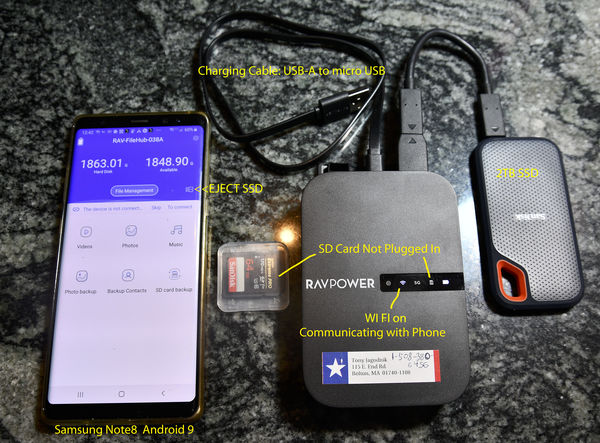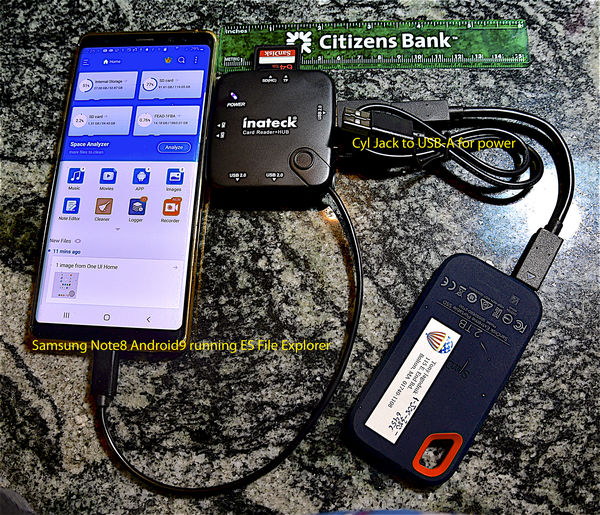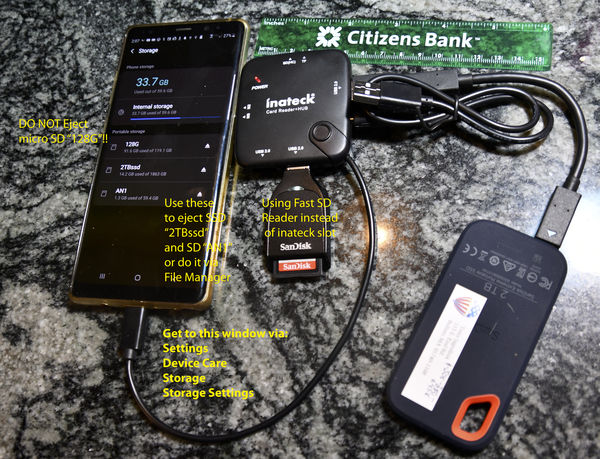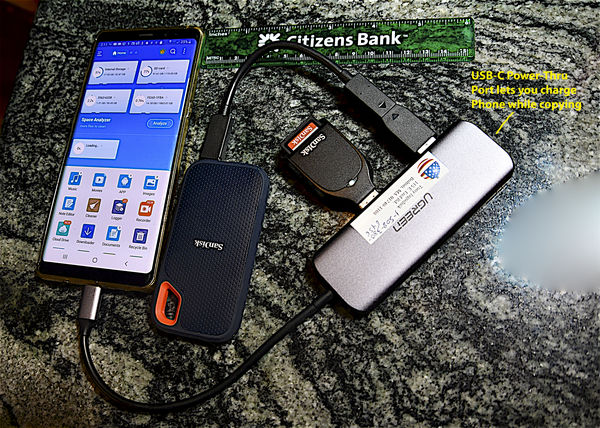Backing up SD Cards to SSD Sans Lap Top
Oct 30, 2019 03:31:24 #
As promised in an earlier thread,
https://www.uglyhedgehog.com/t-610782-1.html,
the comparison among techniques for backing up image /video files from a camera's SD cards without a laptop is completed, for now. In order to share this information with anyone interested, and to incorporate any additional inputs, it is attached to this thread as an Excel comparison spreadsheet, which references 4 annotated photos. This effort has been a challenge to maintain apples-to-apples and because new products and reviews, referenced in the spreadsheet, appear almost every day. Many are You-Tube videos, which seem to have lots of duplication and usually don't reference each other. But each adds new info, a different work flow, equipment, and viewpoint. Some offer a discount code. Some reviewers changed their minds, so look at the latest. Many are for older versions that are not listed in the spreadsheet.
The first tab covers Hubs for use in Multi-Box solutions, which tend to be very low-cost. I already had or bought the hardware for 3 of these and ran some experiments to measure copy speed from SD to SSD, which generally agree with those posted in the reviews. Without repeating here all of the detail in the spreadsheet, here are some overall conclusions.
1. Copy speed from SD to SSD varies from about 8 MB/s, with an old. slow SD card, to 12-16 MB/s with a SanDisk SD claimed to read at 170 MB/s (amazingly faster than the UHS-I limit of 104 MB/s), given the proper SanDisk reader.
2. The Kingston Mobillite (Hub2) and an IOS scheme (Hub6) were only 1-5 MB/s, tested by others. Hub6 is likely to improve.
3. Hub1 (RAVPOWER File Hub) and Hub2 have a built-in Battery, so can also serve as a power store.
4. Hub1 and 2 have wi-fi and can be controlled from a smart phone app (Android or IOS), while 3-5 need a file manager running on Android with OTG USB, but there is an IOS capability emerging (Hub6).
5. Practice to be sure you can handle basic file management techniques like creating and naming folders, copying and deleting files, ejecting drives, etc.
6. Hubs 7 and 8 did not work from my Android phone; they don't seem to support OTG USB.
7. At the bottom of the first tab are some results showing that internal to the Note8 or MacBook pro, i.e. not through USB, the transfer rates jump to 40 and 80 MB/Sec respectively. Data needs to pass port-to-port in both directions while write speed is usually slower, so using a USB hub would seem to limit speed to less than half of these internal speeds, (20 MB/s for the phone) as observed.
The second tab includes a list of some SSDs of various sizes. I own only the 2TB SanDisk Extreme, which was used in all speed measurements. I wish it had an activity indicator LED and a write protect switch. There is also a couple of 2.5" SATA internal drives, which seem to be a bit cheaper and could be used with a USB adaptor or within the NEXTO Single Box Solution SB3.
Finally, the second tab also lists four Single Box Solutions, which are all faster, bigger, heavier, much more than just storage, and far more expensive than the Multi-Box solutions. The NEXTO DI NPS-10 (SB3) and Gnarbox 2.0 (SB4) even support dual write to their internal SSD plus an external SSD, forming a sort of RAID1 configuration (no longer Single-Box). I don't own any of these, so the performance numbers in the spreadsheet are all by the various references. All of them have incremental write, so you can leave images on your SD cards as yet another form of backup, without slowing down as they fill up.
The LaCie DJO Co-Pilot (SB1) is the least expensive, likely because it has a spinning hard drive. It will probably be available with SSD in the future. The NEXTO DI NPS-10 (SB3) comes without any drive, but has a slot for a 2.5" SATA drive, which can be replaced as technology advances and your needs grow. It also comes with UHS-II SD slots, supporting their faster speeds. The Gnarbox 2.0 (SB4) has the newer NVMe SSD technology, but so far maxes out at 1TB.
Overall, except for Hub6, no reviewers addressed the need to EJECT (unmount) the SSD when done. This can be important to avoid corrupting the SSD, which happened to me during experiments. I was able to repair it using Disk Utility on my MacBookPro, but the whole point of this study is to avoid dragging it to Antarctica. You can EJECT via Android settings or via most file managers, or just wait until you are absolutely sure the SSD is not being accessed.
The 3 schemes i tested don't weigh much and offer some diversity, thus will all be going to Antarctica in December. Eliminating the weight of the MacBook Pro and charging/interface parephernalia will likely allow for one more big lens. And I won't be staying up late post processing. The phone is also a backup camera itself and can also collect images from my D7500 via Snap Bridge, another form of backup. I will get a 0.5TB microSD card or maybe even a new S10+.
I hope you find this comparison useful or at least somewhat interesting. Comments, corrections, observations, your personal experiences, or additional schemes will be welcome and i will revise the spreadsheet to accommodate them as necessary. Thanks.
https://www.uglyhedgehog.com/t-610782-1.html,
the comparison among techniques for backing up image /video files from a camera's SD cards without a laptop is completed, for now. In order to share this information with anyone interested, and to incorporate any additional inputs, it is attached to this thread as an Excel comparison spreadsheet, which references 4 annotated photos. This effort has been a challenge to maintain apples-to-apples and because new products and reviews, referenced in the spreadsheet, appear almost every day. Many are You-Tube videos, which seem to have lots of duplication and usually don't reference each other. But each adds new info, a different work flow, equipment, and viewpoint. Some offer a discount code. Some reviewers changed their minds, so look at the latest. Many are for older versions that are not listed in the spreadsheet.
The first tab covers Hubs for use in Multi-Box solutions, which tend to be very low-cost. I already had or bought the hardware for 3 of these and ran some experiments to measure copy speed from SD to SSD, which generally agree with those posted in the reviews. Without repeating here all of the detail in the spreadsheet, here are some overall conclusions.
1. Copy speed from SD to SSD varies from about 8 MB/s, with an old. slow SD card, to 12-16 MB/s with a SanDisk SD claimed to read at 170 MB/s (amazingly faster than the UHS-I limit of 104 MB/s), given the proper SanDisk reader.
2. The Kingston Mobillite (Hub2) and an IOS scheme (Hub6) were only 1-5 MB/s, tested by others. Hub6 is likely to improve.
3. Hub1 (RAVPOWER File Hub) and Hub2 have a built-in Battery, so can also serve as a power store.
4. Hub1 and 2 have wi-fi and can be controlled from a smart phone app (Android or IOS), while 3-5 need a file manager running on Android with OTG USB, but there is an IOS capability emerging (Hub6).
5. Practice to be sure you can handle basic file management techniques like creating and naming folders, copying and deleting files, ejecting drives, etc.
6. Hubs 7 and 8 did not work from my Android phone; they don't seem to support OTG USB.
7. At the bottom of the first tab are some results showing that internal to the Note8 or MacBook pro, i.e. not through USB, the transfer rates jump to 40 and 80 MB/Sec respectively. Data needs to pass port-to-port in both directions while write speed is usually slower, so using a USB hub would seem to limit speed to less than half of these internal speeds, (20 MB/s for the phone) as observed.
The second tab includes a list of some SSDs of various sizes. I own only the 2TB SanDisk Extreme, which was used in all speed measurements. I wish it had an activity indicator LED and a write protect switch. There is also a couple of 2.5" SATA internal drives, which seem to be a bit cheaper and could be used with a USB adaptor or within the NEXTO Single Box Solution SB3.
Finally, the second tab also lists four Single Box Solutions, which are all faster, bigger, heavier, much more than just storage, and far more expensive than the Multi-Box solutions. The NEXTO DI NPS-10 (SB3) and Gnarbox 2.0 (SB4) even support dual write to their internal SSD plus an external SSD, forming a sort of RAID1 configuration (no longer Single-Box). I don't own any of these, so the performance numbers in the spreadsheet are all by the various references. All of them have incremental write, so you can leave images on your SD cards as yet another form of backup, without slowing down as they fill up.
The LaCie DJO Co-Pilot (SB1) is the least expensive, likely because it has a spinning hard drive. It will probably be available with SSD in the future. The NEXTO DI NPS-10 (SB3) comes without any drive, but has a slot for a 2.5" SATA drive, which can be replaced as technology advances and your needs grow. It also comes with UHS-II SD slots, supporting their faster speeds. The Gnarbox 2.0 (SB4) has the newer NVMe SSD technology, but so far maxes out at 1TB.
Overall, except for Hub6, no reviewers addressed the need to EJECT (unmount) the SSD when done. This can be important to avoid corrupting the SSD, which happened to me during experiments. I was able to repair it using Disk Utility on my MacBookPro, but the whole point of this study is to avoid dragging it to Antarctica. You can EJECT via Android settings or via most file managers, or just wait until you are absolutely sure the SSD is not being accessed.
The 3 schemes i tested don't weigh much and offer some diversity, thus will all be going to Antarctica in December. Eliminating the weight of the MacBook Pro and charging/interface parephernalia will likely allow for one more big lens. And I won't be staying up late post processing. The phone is also a backup camera itself and can also collect images from my D7500 via Snap Bridge, another form of backup. I will get a 0.5TB microSD card or maybe even a new S10+.
I hope you find this comparison useful or at least somewhat interesting. Comments, corrections, observations, your personal experiences, or additional schemes will be welcome and i will revise the spreadsheet to accommodate them as necessary. Thanks.
Excel spreadsheet (2 tabs, one page each)
Attached file:
(Download)
Fig 1. RAVPOWER File Hub

(Download)
Fig 2. inateck USB-C Card Reader Hub

(Download)
Fig 3. Like Fig 2 , but with fast Sandisk Card Reader instead of inateck SD slot. Also, how to EJECT using Android Settings.

(Download)
Fig 4. Ugreen -USB-C hub with OTG

(Download)
Oct 30, 2019 06:39:12 #
Oct 30, 2019 12:08:46 #
Oct 30, 2019 20:51:48 #
Thanks for the thanks! I have already updated the spreadsheet to correct a few typos, but mainly to include another multi-box solution using the same uni Hub as suggested by Aaron Linsdau, who is pioneering an IOS based version. Speeds are about the same as the other Android schemes. I didn't take any new photos, but referenced those which are similar.
Oct 31, 2019 06:59:31 #
I have the Nexto DI device which you don’t mention. It doesn’t need a phone or Ipad to drive it and its copy speed is blazing. Worked great on my last trip. Check it out!
Oct 31, 2019 07:21:37 #
Jacqui Burke wrote:
I have the Nexto DI device which you don’t mention. It doesn’t need a phone or Ipad to drive it and its copy speed is blazing. Worked great on my last trip. Check it out!
Great to hear that you are happy with it! The NEXTO DI NPS-10- is in the spread sheet as SB3 and has the fastest claimed copy speed. Did you measure it? If so, I would be happy to include your result, but please note which card and which internal drive you used. Thanks.
Oct 31, 2019 10:53:34 #
I agree about Nexto DI!!! Don't need a card reader or iPhone. Insert SD card copy to internal SSD then copy out to external SSD. Compact, simple. Consider external power supply if downloading large/multiple cards.
Oct 31, 2019 21:56:42 #
Thanks to jno and Jacqui Burke for the NEXTO DI recommendations. It does sound like a good choice. I found another You Tube by Alistar Chapman, who observed a copy speed of about 304 MB/Sec from an XQD card. I have some questions for NEXTO, but perhaps you could answer them:
1. Can you charge it’s battery while it is operating?
2. Can you run it with only an external SSD, e.g. 2TB Sandisk Extreme Portable USB3.1, which I already own?
3. The list of recommended internal SSDs does not include the SanDisk 2TB 3D SATA 2.5” drive….will that work?
4. Do both SD card slots have the second row of contacts to support UHS-II cards?
5. When using a fast UHS-I card like the 64 GB SanDisk Extreme Pro U3 C10 V30 170MB/s, what copy rate would you expect?
6. Is there a way to EJECT the drive(s) when done?
7. Will it accept firmware updates?
8. Is there any Android or IOS app that would allow more detailed control of it?
Thanks
1. Can you charge it’s battery while it is operating?
2. Can you run it with only an external SSD, e.g. 2TB Sandisk Extreme Portable USB3.1, which I already own?
3. The list of recommended internal SSDs does not include the SanDisk 2TB 3D SATA 2.5” drive….will that work?
4. Do both SD card slots have the second row of contacts to support UHS-II cards?
5. When using a fast UHS-I card like the 64 GB SanDisk Extreme Pro U3 C10 V30 170MB/s, what copy rate would you expect?
6. Is there a way to EJECT the drive(s) when done?
7. Will it accept firmware updates?
8. Is there any Android or IOS app that would allow more detailed control of it?
Thanks
Oct 31, 2019 23:49:59 #
[quote=tonyjag]Thanks to jno and Jacqui Burke for the NEXTO DI recommendations. It does sound like a good choice. I found another You Tube by Alistar Chapman, who observed a copy speed of about 304 MB/Sec from an XQD card. I have some questions for NEXTO, but perhaps you could answer them:
1. Can you charge it’s battery while it is operating? Yes
2. Can you run it with only an external SSD, e.g. 2TB Sandisk Extreme Portable USB3.1, which I already own? Yes, absolutely.
6. Is there a way to EJECT the drive(s) when done? I didn't try until I returned home and then just disconnected the drive- no formal eject process needed.
7. Will it accept firmware updates? Yes
Here is a review that I posted at B&H for the Nexto DI: Ididn't want to lug a laptop on a recent two week safari but wanted a backup solution for photos. Some people bring extra memory cards but that's not a back up - it's still only one copy (unless your camera has two card slots and you use one strictly for a second copy). There are a couple of small, inexpensive, wi-fi based solutions that work through a phone app but the one I tried was slow and wholly unsatisfying. This product is expensive - you can buy a chrome book in this price range and do the same thing. But this product is smaller and lighter than a subcompact computer. More importantly it does precisely what it is designed to do! I did not install an SSD into the box as I had an external SSD which worked the same way via cable. Backup speeds were very quick though it takes a few minutes if you have many large (raw) files and choose the option to Verify each file. There is only one control to be used. It is a combination wheel / button. Wheel for scrolling among options on the screen and the button (long hold or short hold) to choose the options as indicated or shut down. Easy to use. The unit has its own battery and I was able to perform at least 10 backups (with Verification) before it needed to be recharged. In a two week trip I only needed to recharge it once. It is convenient to be able to insert multiple memory cards at one time and it will back them up sequentially and properly (appending previous backups if appropriate). The back up file structure appears to be a separate folder for each memory card. You drill down in each folder to find the files / photos. Not a problem. The battery strength indicator is a little deceiving as it appeared to have two (of three) bars and then ran out of juice. At least it told me that the back up was not successful so I was able to perform it again after recharging. Price aside this product did exactly what it's designed to do and made me very happy I had it.
1. Can you charge it’s battery while it is operating? Yes
2. Can you run it with only an external SSD, e.g. 2TB Sandisk Extreme Portable USB3.1, which I already own? Yes, absolutely.
6. Is there a way to EJECT the drive(s) when done? I didn't try until I returned home and then just disconnected the drive- no formal eject process needed.
7. Will it accept firmware updates? Yes
Here is a review that I posted at B&H for the Nexto DI: Ididn't want to lug a laptop on a recent two week safari but wanted a backup solution for photos. Some people bring extra memory cards but that's not a back up - it's still only one copy (unless your camera has two card slots and you use one strictly for a second copy). There are a couple of small, inexpensive, wi-fi based solutions that work through a phone app but the one I tried was slow and wholly unsatisfying. This product is expensive - you can buy a chrome book in this price range and do the same thing. But this product is smaller and lighter than a subcompact computer. More importantly it does precisely what it is designed to do! I did not install an SSD into the box as I had an external SSD which worked the same way via cable. Backup speeds were very quick though it takes a few minutes if you have many large (raw) files and choose the option to Verify each file. There is only one control to be used. It is a combination wheel / button. Wheel for scrolling among options on the screen and the button (long hold or short hold) to choose the options as indicated or shut down. Easy to use. The unit has its own battery and I was able to perform at least 10 backups (with Verification) before it needed to be recharged. In a two week trip I only needed to recharge it once. It is convenient to be able to insert multiple memory cards at one time and it will back them up sequentially and properly (appending previous backups if appropriate). The back up file structure appears to be a separate folder for each memory card. You drill down in each folder to find the files / photos. Not a problem. The battery strength indicator is a little deceiving as it appeared to have two (of three) bars and then ran out of juice. At least it told me that the back up was not successful so I was able to perform it again after recharging. Price aside this product did exactly what it's designed to do and made me very happy I had it.
Nov 1, 2019 00:23:24 #
.... Price aside this product did exactly what it's designed to do and made me very happy I had it.[/quote]
Thanks so much for the great feedback! It is expensive, but not bad compared to the other "single box" alternatives and certainly in the noise compared to the overall cost of going to Antarctica next month, an expedition very unlikely to be repeated at my age (75). So i don't want to lose any pictures or movie clips from my D7500. My son will also be going and using my D5300 as backup, thus the ability to handle 2 SD cards at once every evening on the Nat Geo Explorer, the great copy speeds, and incremental back up would be welcome. I am corresponding with NEXTO and will post their answers when they are complete.
Thanks so much for the great feedback! It is expensive, but not bad compared to the other "single box" alternatives and certainly in the noise compared to the overall cost of going to Antarctica next month, an expedition very unlikely to be repeated at my age (75). So i don't want to lose any pictures or movie clips from my D7500. My son will also be going and using my D5300 as backup, thus the ability to handle 2 SD cards at once every evening on the Nat Geo Explorer, the great copy speeds, and incremental back up would be welcome. I am corresponding with NEXTO and will post their answers when they are complete.
Nov 1, 2019 00:58:09 #
tonyjag wrote:
tonyjag, Thanks for the thanks! I have already updated the spreadsheet to correct a few typos, but mainly to include another multi-box solution using the same uni Hub as suggested by Aaron Linsdau, who is pioneering an IOS based version. Speeds are about the same as the other Android schemes. I didn't take any new photos, but referenced those which are similar.
Please don’t misconstrue what I write here as some form of one-upmanship or worse, as if I were to say, “So what," as I am not. I’m sure I don’t have nearly so sophisticated an understanding as you do, but given the theme of SD Back-up to SSD, my visceral response just now was akin to what one of my New Orleans-area housekeepers would say, "Too much job" in answer to my wife’s request to do some difficult cleaning chore.
My scheme, which I have used when traveling abroad, is conceptually much simpler, but it does involve, dare I write this, an iPad. it also uses an SD card reader to Lightning adapter and iXpand flash drives (which are SSD.) Simply put, one downloads SD card data to the iPad, then uploads the images from the iPad to the iXpand flash drive. No need for a spreadsheet or any other software.
Nov 1, 2019 10:12:47 #
lev29 wrote:
tonyjag,
....
My scheme, which I have used when traveling abroad, is conceptually much simpler, but it does involve, dare I write this, an iPad. it also uses an SD card reader to Lightning adapter and iXpand flash drives (which are SSD.) Simply put, one downloads SD card data to the iPad, then uploads the images from the iPad to the iXpand flash drive. No need for a spreadsheet or any other software.
....
My scheme, which I have used when traveling abroad, is conceptually much simpler, but it does involve, dare I write this, an iPad. it also uses an SD card reader to Lightning adapter and iXpand flash drives (which are SSD.) Simply put, one downloads SD card data to the iPad, then uploads the images from the iPad to the iXpand flash drive. No need for a spreadsheet or any other software.
Lev29,
Thanks for your response, which is much appreciated. It appears that your scheme avoids using any hub by employing a 2-step process, SD card to iPad, then iPad to SSD. That is different from any of the schemes listed in the spreadsheet (which is a tool to compare various schemes and not part of any solution). It is intended to help travelers decide which scheme(s) best fits their needs. If you can provide a little more detail and some speed measurements, I would be happy to add your scheme to the spreadsheet.
Now I need to go take care of all the leaves brought down by our windy night here in Central Massachusetts.

Nov 1, 2019 10:29:31 #
tonyjag wrote:
.... ... I am corresponding with NEXTO and will post their answers when they are complete.
Here are the answers from NEXTO:
"1. Can you charge it’s battery while it is operating?
- During standalone mode(backup or Preview), NPS-10 does not charge for power compatibility issue.
- During PC connection, NPS-10 charge internal battery while working as external USB disk.
2. Can you run it with only an external SSD, e.g. 2TB Sandisk Extreme Portable USB3.1, which I already own?
- Yes. If you don’t attaché internal disk and power on, NPS-10 asks you connecting external USB disk.
- We call it E-copy mode.
3. The list of recommended internal SSDs does not include the SanDisk 2TB 3D SATA 2.5” drive….will that work?
- Yes. But after firmware version V1.05.
4. Do both SD card slots have the second row of contacts to support UHS-II cards?
- YES.
5. When using a fast UHS-I card like the 64 GB SanDisk Extreme Pro U3 C10 V30 170MB/s, what copy rate would you expect?
- It depends how many files inside. If there are only few big files, upto 270MB/s.
- If there are many(>5K) small files, around the same 170~200MB/s.
6. Is there a way to EJECT the drive(s) when done?
- The back plate of NPS-10 is locked by single coin-lock. You can open it using coin. So you can add/remove drive easily."
Further clarification:
"When NPS-10 working stand alone mode, it does manage logical ejection by sending IDLE command to SATA or Sleep to USB device.
But when connected to computer or smart phone, NPS-10 is completely depends on the Host device. No native reject function during the computer connection.
But there were improvement on SSD & HDD itself. Theseday HDD/SSD go into sleep mode automatically if there are no access for certain seconds."
"7. Will it accept firmware updates?
- Yes. Even firmware breaks, it can be updated by usual method.
8. Is there any Android or IOS app that would allow more detailed control of it?
- No. But it has ‘Smartphone I/F’ mode. At that mode, you can connect NPS-10 to Android phone using USB OTG cable.
- Also, you can do the same if you upgrade to iOS13 which released at this September."
Further clarification:
"...YES. You can connect your phone to NPS-10 and just can browse files just like you do at the computer."
I think you could also use use that to backup pictures from the phone.
They also sent a few corrections that i will include in the next spreadsheet revision. I am impressed that they have been so responsive.
Nov 1, 2019 11:26:58 #
tonyjag wrote:
Yup, the leaves are dropping all around Eastern Massachusetts as well. Umh, did I miss something? Where is this spreadsheet you write about?Lev29, br Thanks for your response, which is much ... (show quote)
Nov 1, 2019 11:51:39 #
It is an attached file, which you can download. The second one is the latest version posted and I am working on a third.
If you want to reply, then register here. Registration is free and your account is created instantly, so you can post right away.


